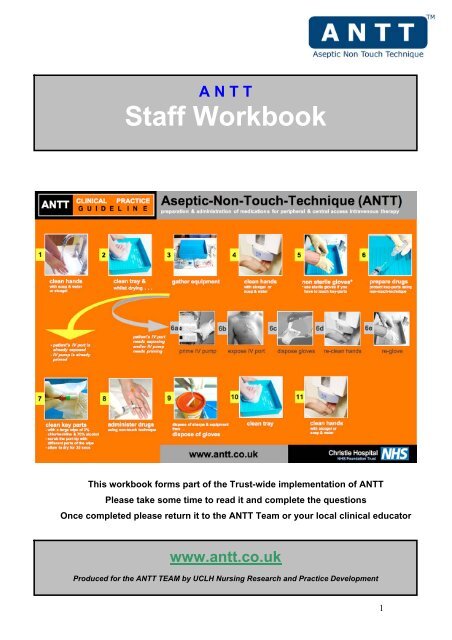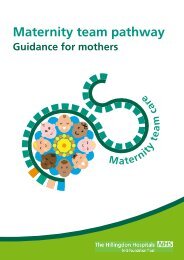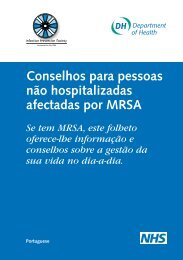Staff Workbook - Hillingdon Hospital NHS Trust
Staff Workbook - Hillingdon Hospital NHS Trust
Staff Workbook - Hillingdon Hospital NHS Trust
Create successful ePaper yourself
Turn your PDF publications into a flip-book with our unique Google optimized e-Paper software.
A N T T<br />
<strong>Staff</strong> <strong>Workbook</strong><br />
This workbook forms part of the <strong>Trust</strong>-wide implementation of ANTT<br />
Please take some time to read it and complete the questions<br />
Once completed please return it to the ANTT Team or your local clinical educator<br />
www.antt.co.uk<br />
Produced for the ANTT TEAM by UCLH Nursing Research and Practice Development<br />
1
Completing this workbook:<br />
Before completing this workbook you should have had opportunity to see the<br />
following ANTT educational resources:<br />
ANTT poster<br />
(Gives an overview of the ANTT implementation plan in your area).<br />
ANTT DVD or video<br />
(Introduces ANTT, explains the need for it and demonstrates the guideline).<br />
ANTT training presentation<br />
(Runs through the guideline step by step in more detail).<br />
The answers to the questions in this book are found in these resources. In<br />
addition the attached ANTT article from the Nursing Times provides most of<br />
the answers too.<br />
Introduction<br />
ANTT is a safe, modern, and efficient evidence-based aseptic technique. It<br />
has been shown to significantly improve the clinical behaviour of staff<br />
performing aseptic technique.<br />
This workbook will apply ANTT to IV therapy; however, ANTT can be applied<br />
to any procedure where an aseptic technique is required.<br />
The principles of ANTT are SIMPLE. But even the simplest things will be<br />
forgotten. The best way to ensure compliance is to undertake periodic<br />
updating and assessment.<br />
The principles of ANTT are simple:<br />
• Always wash hands effectively.<br />
• Non-touch-technique is used at all times to protect key-parts.<br />
• Touch non-key parts with confidence<br />
• Take appropriate infective precautions.<br />
ANTT is the mandatory standard aseptic technique in this hospital.<br />
It is important that YOU follow the order of the guideline exactly; this<br />
workbook will show you how.<br />
Remember …<br />
5000 – 15,000 patients die annually of hospital acquired infections. A high<br />
percentage of these patients acquire infection through clinical procedures<br />
such as IV therapy.<br />
Clinical procedures such as IV therapy and wound care put patients at high<br />
levels of risk – largely avoidable risk.<br />
ANTT is a robust aseptic technique that is implemented robustly too.<br />
2
Evidence<br />
ANTT has been implemented by many <strong>NHS</strong> hospitals (See www.antt.co.uk).<br />
It has been shown to improve the clinical (aseptic) behaviour of staff – when<br />
implemented robustly.<br />
For example:<br />
A <strong>Trust</strong> wide study by Clinical Practice Facilitators (CPF) in 2002 at<br />
University College London <strong>Hospital</strong>s <strong>NHS</strong> Foundation <strong>Trust</strong> (UCLH)<br />
identified that aseptic practice across was approximately 50% safe and 50%<br />
unsafe. This has been shown to be typical of most pre ANTT audits in<br />
different hospitals between 2002 and 2008.<br />
ANTT can have a positive effect on clinical practice behaviour.<br />
The ‘ANTT effect’<br />
Poor practice identified across UCLH Nov 2002.<br />
(Practice approximately 50% poor).<br />
Poor practice identified across UCLH 2002, 6 months post<br />
ANTT introduction.<br />
1. Were hands washed pre-procedure?<br />
2. Was hand clean effective?<br />
3. Was aseptic field appropriate?<br />
4. Was aseptic field managed well?<br />
5. Were key-parts contaminated?<br />
6. Was a non-touch-technique used?<br />
7. Were hands washed at the prep stage?<br />
8. Were key-parts allowed to dry?<br />
9. Were hands washed after glove removal?<br />
3
Step 1<br />
If you have very recently cleaned your hands and have not contaminated them since<br />
proceed straight to Step 2. Otherwise,<br />
• Clean your hands effectively with soap and water or alcohol gel<br />
• Use the hospitals 7 step hand washing technique - below<br />
Effective hand washing technique<br />
Palm-to-palm<br />
Rubbing of backs of<br />
fingers into palms<br />
Palm over back of the hand<br />
with interlocking fingers.<br />
Swap hands<br />
Rotational rubbing of thumb<br />
clasped over opposite palm,<br />
swap hands<br />
Palm-to-palm,<br />
interlocking fingers<br />
Rotational rubbing of<br />
fingers into palms,<br />
swap hands<br />
Finish by rubbing hands-to-wrists on both hands<br />
1<br />
4
Step 2<br />
• With clean hands clean your plastic tray thoroughly with a large alcohol wipe.<br />
Clean the inside first, then the outside ending with the bottom of the tray.<br />
• Allow to dry for at least 30 seconds. This is now your prtable aseptic field.<br />
Remember …<br />
If it is not dry, it is not aseptic<br />
2<br />
PAPER TRAYS ARE BANNED<br />
as aseptic fields.<br />
5
Step 3<br />
Step 4<br />
• Whilst the tray dries, gather all your equipment, medications etc., and place<br />
them around the tray<br />
(Collect everything you require before you clean your hands – so as not<br />
contaminate them).<br />
• Now you have cleaned your tray and gathered your equipment you can perform<br />
your final hand clean before preparation<br />
• Clean hands with Alco-gel or soap & water<br />
• Use the hospitals 7 step hand washing technique.<br />
3<br />
4<br />
6
Q. What does cleaning your hands actually achieve?<br />
_______________________________________________<br />
Q. What are the 7 steps to good hand washing technique?<br />
1. ________________________________________________<br />
2. ________________________________________________<br />
3. ________________________________________________<br />
4. ________________________________________________<br />
5. ________________________________________________<br />
6. ________________________________________________<br />
7. ________________________________________________<br />
Step 5<br />
• Put on non-sterile gloves<br />
• Risk Assessment: To decide between sterile or non-sterile gloves<br />
simply ask this question: ‘Can I do this procedure without touching keyparts?’<br />
If no, wear sterile gloves<br />
However, nearly always the answer will be YES<br />
Therefore, wear non-sterile gloves<br />
(Glove wearing at the drug preparation stage is mandatory to protect the<br />
clinician from drug exposure (COSHH regulations) and to limit the<br />
compromise of asepsis should you inadvertently touch key parts).<br />
7<br />
5
Step 6<br />
• Assemble your equipment and protect key-parts at all times.<br />
• Prepare medications using a non-touch-technique<br />
• Touch non key-parts with confidence<br />
• After drug prep - go straight to the patient & do not contaminate your<br />
gloves<br />
• Do not DROP your equipment into your tray – This increases the risk<br />
of contaminating key-parts.<br />
(Key-parts should not be touched by anything, other than other<br />
aseptic key-parts).<br />
8<br />
6
Don’t leave key-parts<br />
unprotected<br />
Key-parts should be protected<br />
in this way<br />
Q. What constitutes a key-part in the ANTT IV Therapy Guideline?<br />
Q. If you are wearing gloves can you then touch key-parts?<br />
YES / NO Your rationale?<br />
9
Q. What can you put into your tray?<br />
This would be ideal<br />
This would also be fine. Because …<br />
The paper wrapping should be dry and<br />
aseptic<br />
The key parts are protected<br />
The aseptic field is organised<br />
(Don’t put unnecessary items<br />
in the tray).<br />
NEVER flick off key-parts such as<br />
needles or caps<br />
Your thumb is likely to touch<br />
the key-part<br />
Q. Do you need an aseptic or sterile field to administer IV medications?<br />
Explain your answer.<br />
___________________________________________________<br />
____________________________________________________<br />
10
At this stage of the guideline (between preparation and administration) you<br />
have a choice. If you have pre-prepped the patient and can access the<br />
port without contaminating your gloves you can proceed straight to<br />
step 7. If not, you need to follow Steps 6a to 6e.<br />
• Patient’s IV<br />
port is<br />
already<br />
exposed<br />
• IV pump is<br />
already<br />
primed<br />
To re-cap…<br />
If you cannot get to the patient without contaminating your gloves<br />
OR<br />
If you need to prime an IV pump<br />
OR<br />
• Patient’s IV<br />
port needs<br />
exposing<br />
• And / or IV<br />
pump needs<br />
priming<br />
Take down a dressing to expose an IV port<br />
You must follow 6a, 6b, 6c, 6d, and 6e of the ANTT IV<br />
administration guideline<br />
(Tip: Its quicker to prep the patient before Step 1).<br />
11
Step 6a<br />
Step 6b<br />
• If required, prime the patient’s IV pump or infusion device<br />
• Expose the patient’s IV port, ensuring free and unrestricted access<br />
6a<br />
6b<br />
12
Step 6c<br />
Step 6d<br />
• Because you have contaminated your gloves by priming the pump or<br />
removing a bandage etc you will need to re-establish the asepsis of<br />
your hands<br />
• Dispose of your gloves<br />
• Re-clean your hands with alcohol gel or soap and water<br />
(Cleaning hands after glove removal is vital because wearing gloves<br />
encourages the growth of potentially pathogenic micro-organisms naturally<br />
found on and in your skin).<br />
6c<br />
13<br />
6d
Step 6e<br />
Step 7<br />
Remember …<br />
• Re-apply non-sterile gloves<br />
• Clean key parts (in this instance the patient’s IV port)<br />
• Clean with a large wipe of 2% Chlorhexidine & 70% alcohol<br />
• Apply friction by scrubbing the port tip hard with different parts of<br />
the wipe<br />
• Allow to dry for 30 seconds<br />
Its not aseptic – until its DRY<br />
7<br />
14<br />
6e
Step 8<br />
• Administer drugs using a non-touch-technique<br />
Use large size wipes<br />
Small Sterets ® are too<br />
small to clean key-parts<br />
safely<br />
(Non-touch-technique means not touching the key-parts & not<br />
letting the key-parts touch anything else – other than other<br />
aseptic key-parts).<br />
8<br />
15
Step 9<br />
•<br />
• Don’t leave medication vials attached to identify your drugs<br />
(IT WOULD BE DANGEROUS IF THEY WERE TO FALL OUT OF THE TRAY<br />
The bungs often leak around the needle – compromising asepsis).<br />
• Dispose of sharps & equipment<br />
• Then dispose of gloves<br />
9<br />
16
Step 10<br />
Step 11<br />
• Clean your tray<br />
• Allow it to dry properly before putting it away<br />
(Not doing so is a perfect way of creating cross-infection)<br />
• Clean hands with Alco-gel or soap & water<br />
• Use the hospitals 7 step hand washing technique<br />
10<br />
11<br />
17
And finally …<br />
Q. What does ANTT stand for? _________________________________________________<br />
Q. What is a key-part? ________________________________________________________<br />
Q. What is the most essential starting point of ANTT? ______________________________<br />
Q. What are the four (4) main principles of ANTT? _________________________________<br />
Q. What parts of an IV line can be touched? _______________________________________<br />
Q. What should you do following glove removal and disposal? _______________________<br />
Q. What do you clean key-parts with, how and why? ________________________________<br />
___________________________________________________________________________<br />
Q. Do you need to wear gloves if the ANTT guideline is being followed and all main<br />
principles are being observed? Explain your rationale. ____________________________<br />
___________________________________________________________________________<br />
__________________________________________________________________________<br />
Q. Is the order of the guideline optional or mandatory? Why?<br />
___________________________________________________________________________<br />
18






